Beyond Pine Cones
The wonderful world of nuts, berries, fruits, seeds and cones
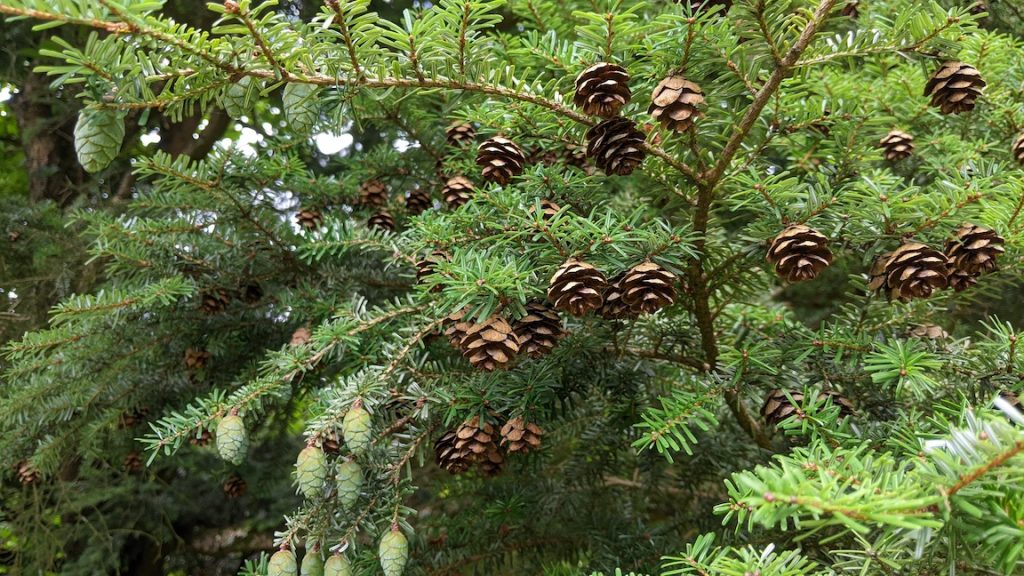
While the exuberance of spring growth and summer blooms has passed, the life cycle of plants continues into the autumn and beyond. Many assume that once the foliage changes color and the leaves drop, that’s it for the year. But that’s not the case for plants.
Plants are ensuring the continuation of the next generation by dispersing seeds via the nuts, berries, fruit and cones that become prominent at this time of the year. Of course, not every future seedling will become a new plant. Most are also important food sources for birds and other wildlife as migration and the winter season approach.
Much like wildlife squirrelling away their finds for the winter ahead, I find myself adding to my personal collection of seeds. My pockets often fill with an assortment of interesting acorns, sweet gum balls, cones and weirdly unusual seed pods I find on walks around Welkinweir this time of the year. You might enjoy starting your own collection of the fruits of the season after learning a bit more about them.
Acorns
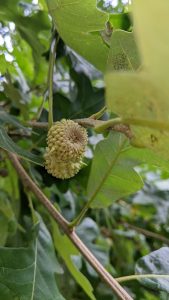
It begins in late summer, when acorns — the seeds of oak trees — start dropping to the ground. Some years see a bumper crop, while other years are leaner. An abundance of acorns occurs during periodic “mast” years (as in 2023) and are scarce in other years. Mast, the fruit of forest trees and shrubs, can be hard (acorns, hickory nuts, beechnuts) or soft (raspberries or blueberries). What’s important to know about mast production is that it’s highly variable, affecting the function of our ecosystems and the dynamics of forests. According to the nature radio program “Something Wild,” “Evolution has favored the oak trees that demonstrate this boom or bust cycle,” keeping seed-eating wildlife populations in balance while allowing some acorns to sprout and become trees.
Each fall, my desk has a small collection of different-looking acorns on it — each species of oak produces acorns of a unique design. Some are round and others elongated, while still others are small or large, but all in a rich range of browns from tan to a red-brown.
Then there are the acorn caps. Some acorns wear their caps like little berets, while other caps cover nearly the entire acorn, not leaving much acorn itself to peek out. And some caps even have fringes, like the mossy cup oak. Given all this variety, it’s not surprising you can identify an oak by its acorn.
Sweet Gum
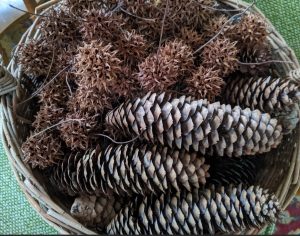
You’ve likely seen sweet gum seeds. A native tree known for its brilliant fall foliage, sweet gum produces hundreds of spiky round fruits in the shape of … a gum ball. Initially green, they turn brown as they dry out. During this drying process, holes appear in the gum ball, with each hole containing two winged seeds, with as many as 30 to 50 seeds per gum ball!
Though gum balls are considered messy and even hazardous (stepping on round gum balls can lead to twisted ankles), the seeds inside the gum balls are an important food source for birds and other wildlife. Collect them to display, or spray paint them for holiday decor. A quick Google search reveals the creativity of people using gum balls in an amazing array of nature crafts.
Magnolia and Tulip Trees
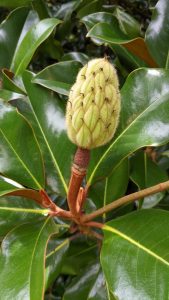
One of the most unusual and strange seed pods is found on spring- and summer-blooming magnolias. If the flowers are pollinated, they produce a cone-shaped aggregate of follicles. These “cones” vary in size by species, appear fuzzy and are somewhat red in color, splitting open to reveal bright orange-red seeds when ripe.
But it’s the other-worldly looking, twisty, lumpy and bumpy seed pods of other magnolias that totally fascinate me. And yes, magnolia seeds can be germinated, although seeds from hybrid magnolias will not grow true to type of the parent tree.
A close cousin of magnolias, the tall native forest tulip tree has yellow, orange and green tulip-shaped spring flowers often seen covering the ground beneath the tree, followed by a cone-shaped seed pod. After the petal-shaped seeds are dispersed by the wind, the remaining seed head looks very much like wooden flowers, ready for use in fall and winter crafts and display. Take care, as they’re delicate and can easily fall apart.
Conifers
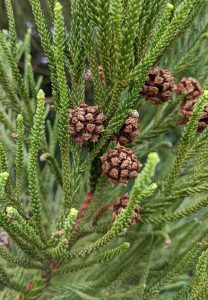
Then there are the “real” cone-bearing plants. Conifers, with their needle-like (think spruce) or scale-like (arborvitae) leaves are typically evergreen (with some exceptions) and bear cones that protect their seeds. Like acorns, cones of conifers come in many sizes and shapes. Spruce, pine, cypress, hemlock and cedar are all examples of conifers found throughout the Welkinweir landscape.
Norway spruce, a large-growing European native conifer, has needle-like leaves that hang down from branchlets and produce an attractive long, slender cone with pointed scales. Similarly, the delicate texture and graceful compact shape of oriental spruce is reflected in its compact cones.
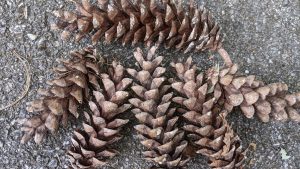
Pines can be distinguished from other conifers by their needles, which are found in bundles of two to five. For example, Eastern white pine, the largest native conifer in the eastern U.S., has long, soft needles in bundles of five. Their three- to eight-inch-long cones are somewhat coarse looking and hang down from the branches. When you find these cones on the ground, they’re often white with sap. The two- to three-needle bundle hard pines, such as Scots and red pine, produce egg-shaped cones, ranging from one and a half to three inches long.
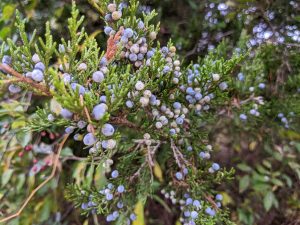
The smallest cones I find on my walks are from our native eastern hemlock (FYI: the Pennsylvania state tree) and Carolina hemlock, both short-needle evergreens with adorably petite one-inch oval cones. Deciduous conifers (which lose their leaves and are the exception I mentioned earlier), including bald cypress, dawn redwood and larch, also have small cones.
Eastern red cedar, a native conifer that’s actually a juniper (yes, nature), has blue berries that look like fruit but are actually cones with soft, fleshy scales.
So, as you explore your favorite leaf peeping spots this fall, be sure to look around and keep an eye out for the wonderful world of nuts, berries, fruits, seeds and cones!
Welkinweir is a 224-acre arboretum and nature preserve where history, horticulture and habitat meet. Located in East Nantmeal Township, 1368 Prizer Rd., Pottstown, Welkinweir is free and open Monday to Friday, 9 a.m. to 4:30 p.m. 610-469- 7543; Welkinweir.org.
Our Favorite Resources
- B&D Builders
- Ball & Ball
- Berk Hathaway Holly Gross
- Berk Hathaway Kit Anstey
- Berk Hathaway M. Schwartz
- Canvas Valley Forge
- Dewson Construction
- DiSabatino Landscaping
- King Construction
- McComsey Builders
- Monument/Sotheby’s Int’l
- Mostardi Nursery
- Mountaintop Construction
- Renewal Dynamics
- Sheller Energy
- White Horse Construction
